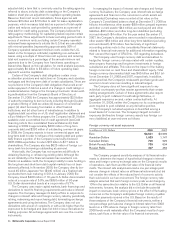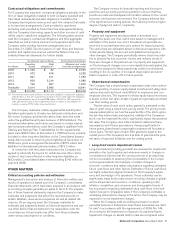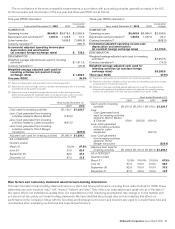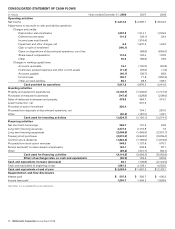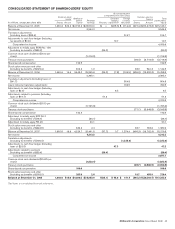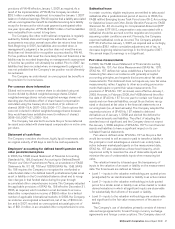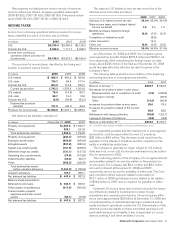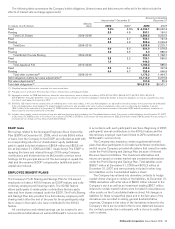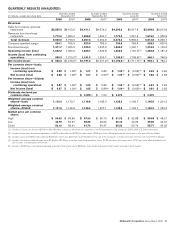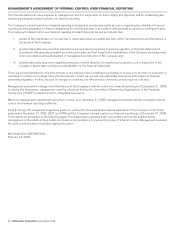McDonalds 2008 Annual Report Download - page 48
Download and view the complete annual report
Please find page 48 of the 2008 McDonalds annual report below. You can navigate through the pages in the report by either clicking on the pages listed below, or by using the keyword search tool below to find specific information within the annual report.hedged and does not hold or issue derivatives for trading purposes.
The counterparties to these agreements consist of a diverse
group of financial institutions. The Company continually monitors its
positions and the credit ratings of its counterparties and adjusts
positions as appropriate. The Company did not have significant
exposure to any individual counterparty at December 31, 2008 and
has master agreements that contain netting arrangements. Some of
these agreements also require each party to post collateral if credit
ratings fall below, or aggregate exposures exceed, certain con-
tractual limits. At December 31, 2008, neither the Company nor its
counterparties were required to post collateral on any derivative
position. At December 31, 2007, the Company was required to post
collateral of $54.8 million, which was used to reduce the carrying
value of the derivatives recorded in other long-term liabilities.
Statement of Financial Accounting Standards No. 133, Account-
ing for Derivative Instruments and Hedging Activities (SFAS
No. 133), as amended, requires companies to recognize all
derivatives as either assets or liabilities on the balance sheet at fair
value. SFAS No. 133 also requires companies to designate all
derivatives that qualify as hedging instruments as fair value hedges,
cash flow hedges or hedges of net investments in foreign oper-
ations. This designation is based upon the exposure being hedged.
The Company’s use of derivatives primarily consists of interest
rate exchange agreements, forward foreign currency exchange
agreements and foreign currency options. These derivatives were
classified on the Consolidated balance sheet at December 31,
2008 as follows: miscellaneous other assets–$87.6 million; pre-
paid expenses and other current assets–$43.8 million; accrued
payroll and other liabilities–$22.1 million; and other long-term
liabilities (excluding accrued interest)–$3.5 million. For the year
ended December 31, 2007, the Company’s derivatives were
recorded in miscellaneous other assets–$63.7 million and other
long-term liabilities (excluding accrued interest)–$70.3 million. All
derivative purchases and settlements are classified in other financ-
ing activities on the Consolidated statement of cash flows.
There was no significant impact to the Company’s earnings
related to the ineffective portion of any hedging instruments for
the three years ended December 31, 2008.
• Fair value hedges
The Company enters into fair value hedges to reduce the exposure
to changes in the fair values of certain liabilities. The fair value
hedges the Company enters into consist of interest rate exchange
agreements which convert a portion of its fixed-rate debt into
floating-rate debt.
For fair value hedges, the gains or losses on derivatives as well
as the offsetting gains or losses on the related hedged items
resulting from changes in fair value are recognized in nonoperating
(income) expense, net.
• Cash flow hedges
The Company enters into cash flow hedges to reduce the
exposure to variability in certain expected future cash flows. The
types of cash flow hedges the Company enters into include
(i) interest rate exchange agreements that effectively convert a
portion of floating-rate debt to fixed-rate debt and are designed to
reduce the impact of interest rate changes on future interest
expense; and (ii) forward foreign exchange contracts and foreign
currency options that are designed to protect against the reduction
in value of forecasted foreign currency cash flows (such as royal-
ties denominated in foreign currencies) due to changes in foreign
currency exchange rates.
For cash flow hedges, the effective portion of the gains or
losses on derivatives is reported in the deferred hedging adjust-
ment component of accumulated other comprehensive income in
shareholders’ equity and reclassified into earnings in the same
period or periods in which the hedged transaction affects earnings.
The remaining gain or loss, if any, is recognized in earnings
currently.
The Company recorded after-tax adjustments related to cash
flow hedges to the deferred hedging adjustment component of
accumulated other comprehensive income in shareholders’ equity.
The Company recorded net increases of $47.3 million, $8.5 million
and $10.7 million for the years ended December 31, 2008, 2007
and 2006, respectively. Based on interest rates and foreign cur-
rency exchange rates at December 31, 2008, the majority of
deferred hedging adjustments, after tax, included in accumulated
other comprehensive income in shareholders’ equity at
December 31, 2008, will be recognized in earnings in 2009 as the
underlying hedged transactions are realized. The maximum
maturity date of any cash flow hedge of forecasted transactions at
December 31, 2008 was 15 months, excluding an instrument
hedging forecasted payments of variable interest on an existing
financial instrument that matures in the fourth quarter of 2010.
• Hedges of net investments in foreign operations
The Company uses forward foreign exchange contracts and for-
eign currency denominated debt to hedge its investments in
certain foreign subsidiaries and affiliates. Realized and unrealized
translation adjustments from these hedges are included in share-
holders’ equity in the foreign currency translation component of
accumulated other comprehensive income and offset translation
adjustments on the underlying net assets of foreign subsidiaries
and affiliates, which also are recorded in accumulated other com-
prehensive income.
During the years ended December 31, 2008, 2007 and 2006,
the Company recorded decreases in translation adjustments in
accumulated other comprehensive income of $31.2 million after
tax (included in the net decrease of $1.2 billion of translation
adjustments on the Consolidated statement of shareholders’
equity), $76.5 million after tax, and $23.2 million after tax,
respectively, related to hedges of net investments.
Sales of stock by subsidiaries and affiliates
As permitted by Staff Accounting Bulletin No. 51 issued by the
Securities and Exchange Commission (SEC), when a subsidiary or
affiliate sells unissued shares in a public offering, the Company
records an adjustment to reflect an increase or decrease in the
carrying value of its investment and a resulting nonoperating gain or
loss. In 2006, the Company’s gain of $32.0 million as a result of the
Chipotle initial public offering (IPO) is reported in discontinued
operations.
Income tax uncertainties
In 2006, the Financial Accounting Standards Board (FASB) issued
Interpretation No. 48, Accounting for Uncertainty in Income Taxes
(FIN 48), which is an interpretation of FASB Statement No. 109,
Accounting for Income Taxes. FIN 48 clarifies the accounting for
income taxes by prescribing the minimum recognition threshold a tax
position is required to meet before being recognized in the financial
statements. FIN 48 also provides guidance on derecognition,
measurement, classification, interest and penalties, accounting in
interim periods, disclosure and transition. The Company adopted the
46 McDonald’s Corporation Annual Report 2008


